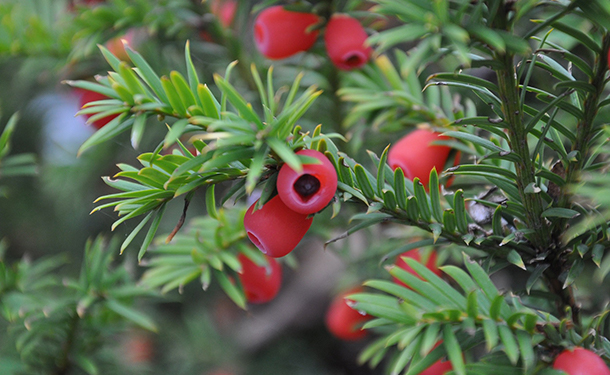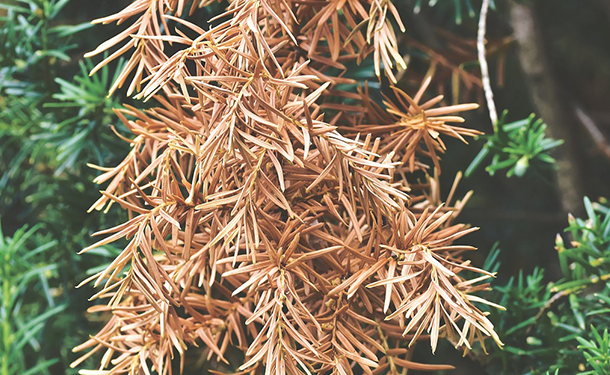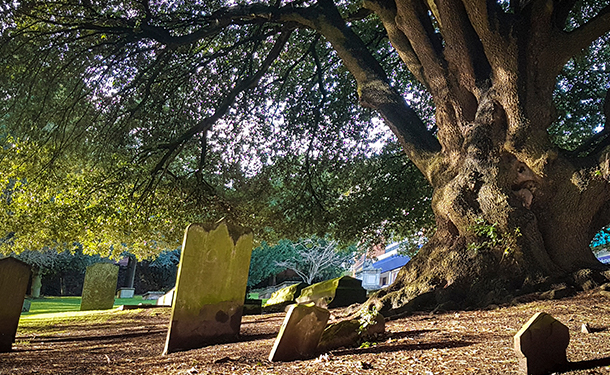Avoid unwittingly planting a tree that is lethal to grazing wildlife, pets and people. Knowing the danger of planting yew trees on your property will help you decide if the risk is worth the threat.

thetreecareguide.com gathered essential care information, toxicity warnings, and some of the mythology associated with the yew tree species.
Yew Tree Species Information
Yews (Taxus baccata) are densely branching, evergreen trees with a large trunk reaching 20 to 30 feet tall. The bark is thin, scaly, and brown; it comes off in small flakes. Its leaves are dark green, leathery, and narrow with a pointed tip.
Yew can be grown in full sun, partial shade, and full shade. For healthier and more lush growth, however, choose a spot that gets several hours of daily sun. Too much shade can result in thin or irregular growth.
This species can live 400 to 600 years, with some specimens exceeding this lifespan. Consider the following when selecting and preparing a growing location for your yew tree:
Soil Preference – This species thrives in rich, loamy, well-drained soil with a neutral to slightly alkaline soil (5.0 to 8.0 pH).
Watering Needs – Established yews require minimal watering. However, during drought conditions, weekly watering is recommended. Adding a layer of mulch around the tree’s base will help retain moisture in well-drained soil.
Fertilizing Yews – Yew trees under 15 years can be fertilized each spring. More mature trees will benefit from feeding every other year. For best growth results, apply a “20-15-15” granular or liquid fertilizer around the yew’s drip line, avoiding the area immediately around the trunk.
Pruning Requirements – This evergreen species is typically pruned twice a year, once in early July and again in early September. Up to 2/3 of new growth can be safely removed to shape this tree during the July pruning. The fall pruning should be a light touch-up to even out any secondary growth.
Hardiness Zone – 3 through 8
Note: Taxus baccata is widely grown in landscapes for decorative purposes or privacy screening, and the species responds well to pruning.
Yew Winter Care
Yews planted in the right conditions can tolerate cold winters without protection. However, they can experience severe winter burn and bleaching. These conditions can be prevented by planting your yew trees on the north-facing side of buildings.
Note: Winter burn occurs when needles and branches repeatedly freeze and are then heated by the winter sun. Read more about protecting your yew during winter weather.

Yew Toxicity
Taxus baccata is a well-known poisonous tree species; all yew parts are deadly poisonous, except for the berry’s flesh. Eating a small quantity of leaves can be fatal for wildlife, livestock, and humans. Yew leaf toxicity is due to alkaloids known as taxines, of which taxine B is suspected as being one of the most poisonous.
Note: Taxine alkaloids are absorbed through the digestive tract incredibly fast, and poisoning signs (nausea, dry mouth, vomiting, stomach pain, dizziness, weakness, nervousness, heart problems, etc.) manifest themselves after 30 to 90 minutes. No antidote is known.
Yew Mythology
The following are some incredible examples of how yews have been embraced by and influenced cultures over millennia:
In Celtic Culture – Old yew tree drooping branches can root and form new tree trunks where they contact the ground. Thus the yew came to symbolize death and resurrection in Celtic culture. The Celts would also have been familiar with the tree’s toxicity.
In Christian Lore – The yew, in particular, symbolizes nature’s power of renewal, the seasons’ cycles, birth and death, and new birth. Over time, the yew remained a symbol of eternity in Christianity. However, the words and focus were changed from ‘rebirth’ to ‘resurrection.’
In Norse Cosmology – The world tree “Yggdrasil” is a massive mythical tree connecting the nine worlds in Norse cosmology. Although typically translated as Ash, it is believed that this tree is likely to have been a Yew.
Ancient Warriors – In ancient times, yews were used for suicides during war times. Food and drink vessels made from yew wood could poison those who ate or drank from them.
The Druids – Yew is typically associated with the dead and is often found in graveyards. The Druids saw yew trees as the guardians of the deceased.

In Greek Mythology – Yew trees are associated with the Greek goddess Hecate, liberator of souls after death.
Note: For as poisonous as yew is, two chemotherapy drugs were developed from yew trees:
- Docetaxel (Taxotere) was first made from the European yew tree’s needles
- Paclitaxel (Taxol) was made from the Pacific yew tree’s bark
Fascinating how a tree so rooted in poison and death can provide treatment and hope for those with severe health concerns.
Yew Trees
In this article, you discovered species planting and care information, severe toxicity warnings, and some of the ancient mythology surrounding the Taxus baccata species.
Knowing the risks of planting a yew tree and how to minimize them will help you grow a stunning tree that can serve as a specimen tree, landscape tree, or privacy hedge.
Unwittingly planting a poisonous yew tree can lead to grazing wildlife, animals, livestock, or unsuspecting people being poisoned.
Sources:
extension.umn.edu/yard-and-garden-news/ask-extension-do-i-need-protect-my-yew-winter
plants.ces.ncsu.edu/plants/taxus-baccata/
heritagegarden.uic.edu/yew-taxus-baccata